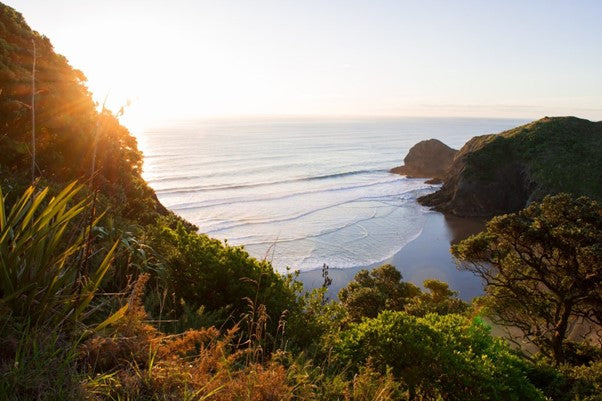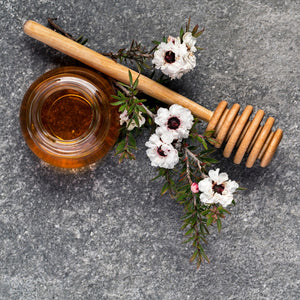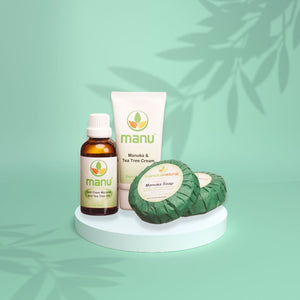
Leptospermum Scoparium - Manuka from New Zealand
Leptospermum Scoparium - Manuka from NZ
Where does Leptospermum Scoparium come from?
Imagine a world where peace and long white clouds rule – a land that is a rich blend of cultures, geologically fascinating landscapes, and unique flora and fauna.
600 islands and splashes of color surround the richness of natural phenomena of bright red flowers that bloom in December.
The land we’re talking about gave the world the most potent honey.
We tickled your imagination, didn’t we?
Leptospermum Scoparium – To understand the real power of Manuka, discover its world first
New Zealand is the most geographically isolated biosystem in the world. It lies in the southwestern part of the Pacific Ocean and consists of two large islands and many small ones.
Geologically, it is located in the underlying area of the Pacific under the huge tectonic plate.
It means that earthquakes and volcanoes are common things. The mineral composition of the soil is extraordinarily diverse and rich.
Also, it is a real paradise for flora combined with a temperate, suitable sea climate, and plenty of moisture.
Nature is preserved here, thanks to the country’s low population density and natural isolation. But also because of the cautious attitude of the natives and immigrants towards their environment.
82% of New Zealand plants are endemic – they are not found anywhere else in the world.
The lack of historical monuments is more than made up for by its unique and perfectly preserved nature. New Zealand is for no reason considered one of the cleanest countries in the world in ecological terms.
Local landscapes are untouched, and the state carefully protects them, considering them its main asset.
The source of purity of manuka honey
The separation from Australia left New Zealand at least 2,000 km away 55 million years ago. This isolation from other landmasses meant that, plants were not replaced or competed with by other species.
They continued to evolve alone – in this unique environment.
When we speak of endemic plants in New Zealand, we refer to plants peculiar only to our islands. All species represent the foundation of our natural ecosystem. Thus are crucial for protecting New Zealand’s biodiversity.
Researchers discovered that many rare species have developed unique characteristics to survive and that these characteristics give plants like (Leptospermum Scoparium) extraordinary benefits.
As a shrubby tree that grows in the North, South, and Stewart Islands, you can find Leptospermum Scoparium , Manuka tree at a low elevation up to 1800 meters above sea level!
You can find manuka trees in many habitats, including, river gravels, wetlands, and dry hillsides.
Known to be very tolerant of drought, waterlogging, frosty conditions, and wind-blasted environments, and it can grow at less fertile sites!
Since you’re about to try our manuka honey (or already like it), it would be interesting to know that in 1984 we decided to protect a large block of 35 acres of native forest remnant.
It was fenced off from the pasture areas and secured with a Queen Elizabeth 2nd Open Space Covenant.
The Covenant now protects this area of native forest in perpetuity. Therefore, it will remain for future generations to enjoy and study regardless of future ownership.
Importance of Endemic Species like Leptospermum Scoparium (Manuka tree)
New Zealand has one of the highest rates of endemism in the world, but why are these endemic species important?
Endemic species are of both local and global importance. They increase genetic diversity and offer insight into biogeographical questions, such as where certain species originated and how distribution patterns have changed over time.
If biodiversity in the region were to drop significantly, there would be a lack of traditional and dependable resources for local peoples.
Local people here rely on their surrounding environment to provide the resources necessary for sustaining life.
For example, traditional healers offer the most common form of medical attention in New Zealand, and they use many plant parts from the surrounding regions in their remedies.
I.e., Leptospermum Scoparium.
These plants have been found to cure various illnesses and have also been used in western pharmaceutical studies.
The medicinal value of these plants is essential to locals. But, also to the entire medical community as the ongoing search for remedies and preventative treatments for many diseases continues.
Leptospermum Scoparium | Trees for bees
Due to its long-term isolation from the rest of the world and its specific island biogeography, New Zealand has vibrant flora and fauna.
The Manuka tree, Leptospermum scoparum, also belongs to this fantastic family.
Manuka is a unique evergreen tree and grows uncultivated. It blooms in summer, and bees adore the intense scent given by its beautiful, white flowers.
It’s no wonder Maori natives have used Leptospermum Scoparium as medicine from ancient times.
For the last 20+ years, intensive work has been done on scientific research on the healing properties of manuka honey. An incredible, 100% natural product created from the beautiful “cooperation” of manuka plants and bees.
Honeybees have the opportunity to gather enough pollen and nectar, which give them vitamins and minerals. This helps maintain a healthy hive population that is capable of pollinating plants efficiently.
Bees consume pollen as a protein and vitamin source and nectar for energy. While gathering these resources, they move pollen from one plant to another, thus benefiting the farm by pollinating crops.
Manuka flowers only grow in hard-to-reach places, which means it takes bees over 22 thousand individual trips to gather enough nectar for one 500 gram jar.
Manuka grows all over New Zealand, however, the highest levels of methylglyoxal producing UMF honey are from the Northern half of the North Island.
It is a small, stunted tree that grows in the coastal regions of the country. The leaves are dark green and glossy, with spiky edges.
This plant has a fascinating history behind it.
Māori were taking advantage of the Leptospermum Scoparium‘s healing properties long before European settlers produced their own form of manuka honey. They used its leaves, bark, seeds, and flowers in a surprising variety of ways:
applied externally to treat scalds and burns
helped with fevers and urinary problems
a ‘tea’ was also used as a sedative and mouthwash
ash from the burned manuka wood was applied directly to help with skin disorders
These days, we know better than ever before how beneficial this plant is.
Island’s treasure – Manuka honey
Honey has been used as a medicine for thousands of years. It was used to treat, from the common cold to seeing wounds. However, the invention of penicillin and antibiotics suppressed honey and many medicinal plants in treatment.
Some natural remedies have been unfairly neglected since then, and among them is undoubtedly honey.
But not every honey is the same.
It is known that bees make honey from various plants. That means the healing properties of honey are directly related to which plant honey comes from.
Some plants are more, and some less medicinal, and that is reflected in the composition of honey.
In 1981, Professor Peter Molan and his team discovered that the honey obtained from the nectar of the manuka tree has an exceptional and constant antibacterial activity. This has not been recorded in other types of honey.
This floral treasure contains many beneficial chemical compounds. It includes organic acids, trace minerals, antimicrobial compounds, vitamin C, A, beta-carotene, and B-group vitamins.
Most importantly it contains Methylglyoxal referred to as MG or MGO which is the organic compound responsible for Manuka honey’s strong antibacterial properties.
In the end…
A couple of factors contributing to this effect of this honey are the high concentration of natural medicinal ingredients, low water content, low acidity, and the presence of specific therapeutic compounds from manuka flowers.
Manuka honey is thick, dark golden, and has a rich taste, with a “hint” of eucalyptus.
Maybe you could meet your taste buds’ wish and enjoy it before you start using it.
And by knowing where does, it come from, connect the body-mind connection faster than ever before.
Originally published on blog.manukanatural.com


